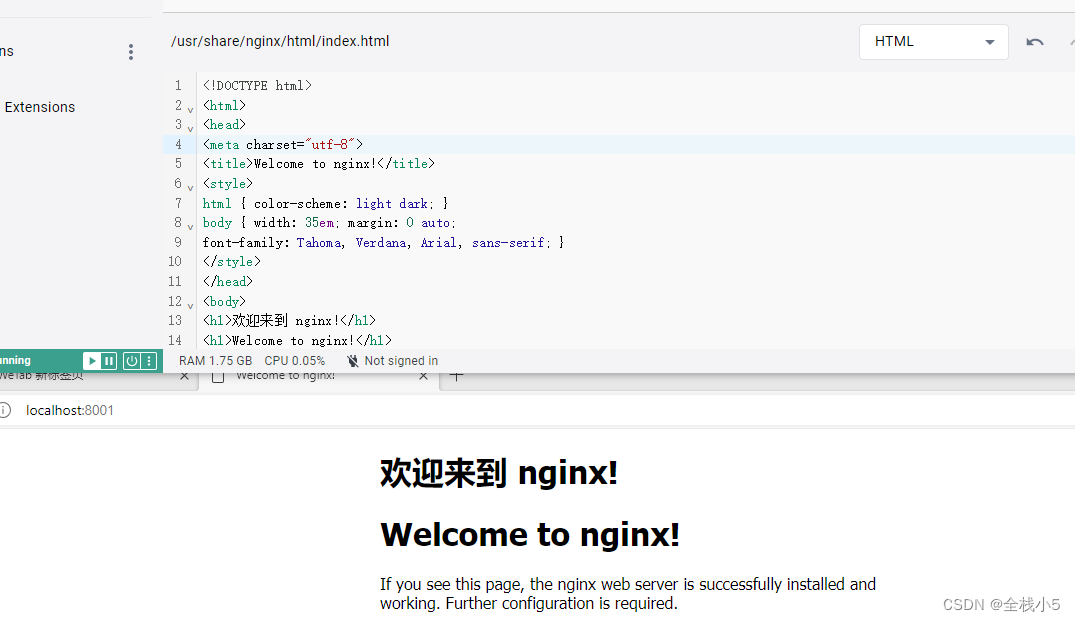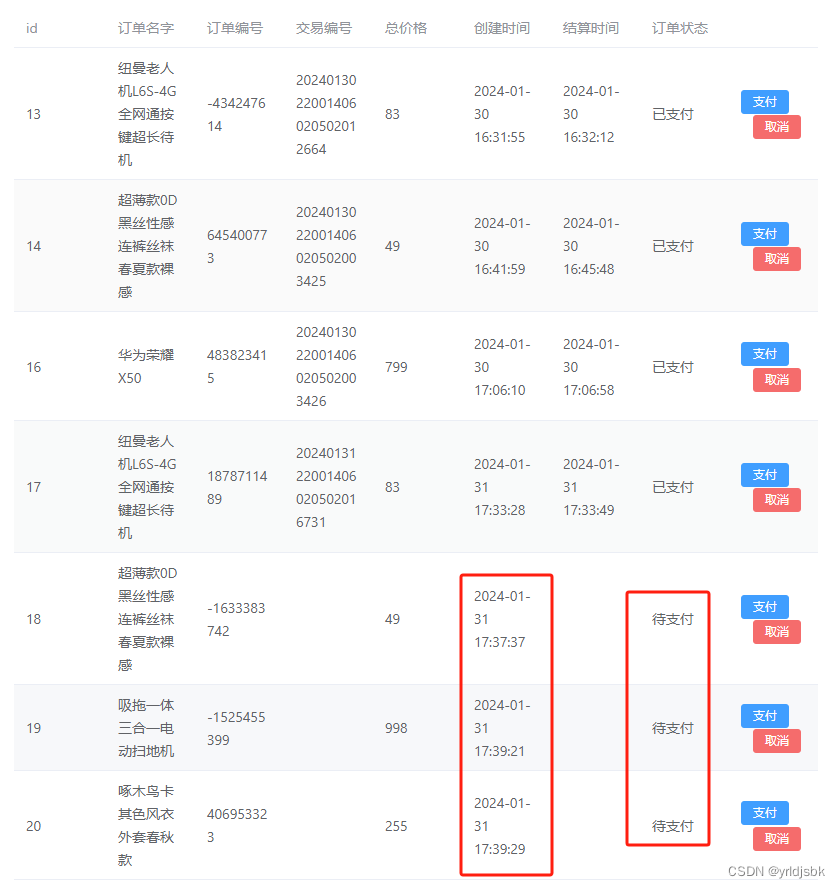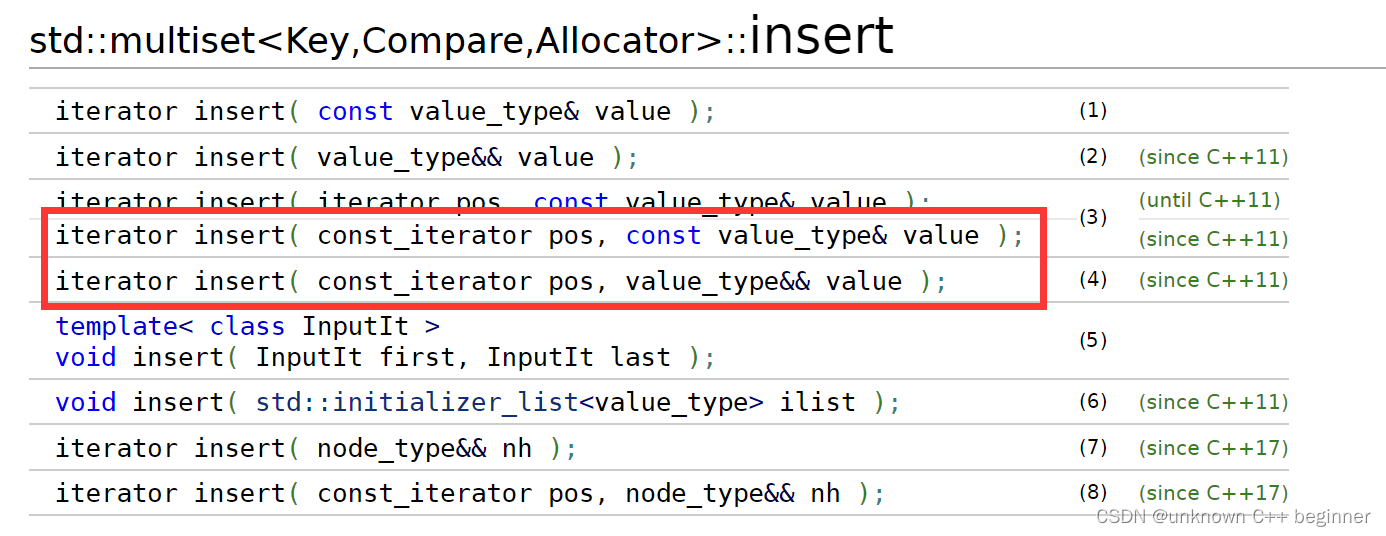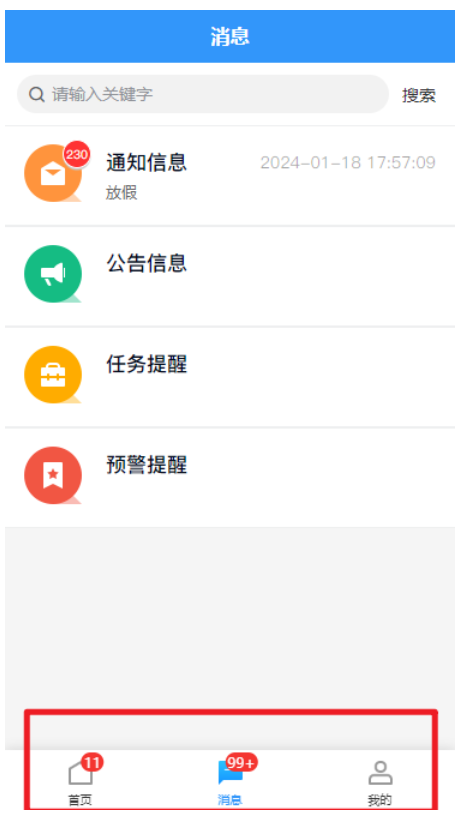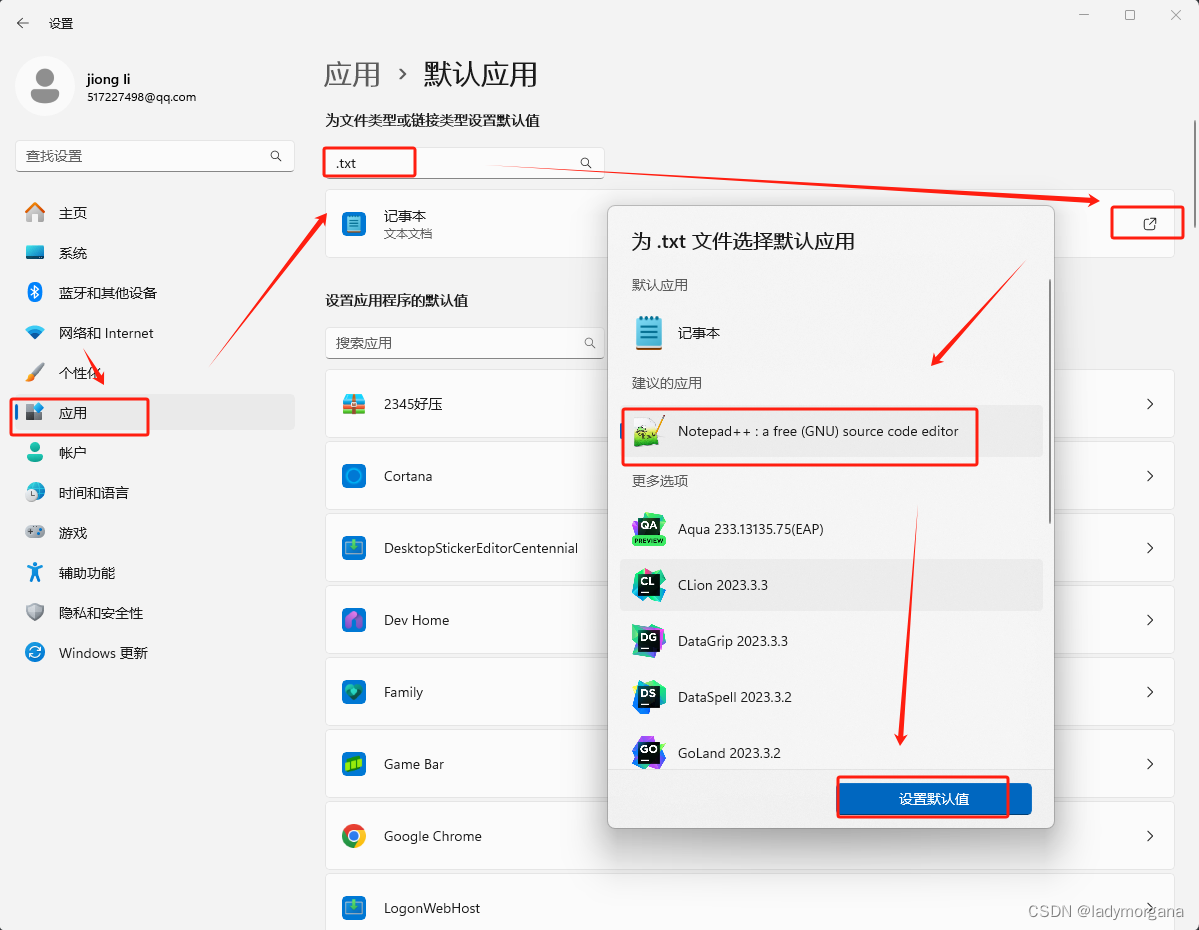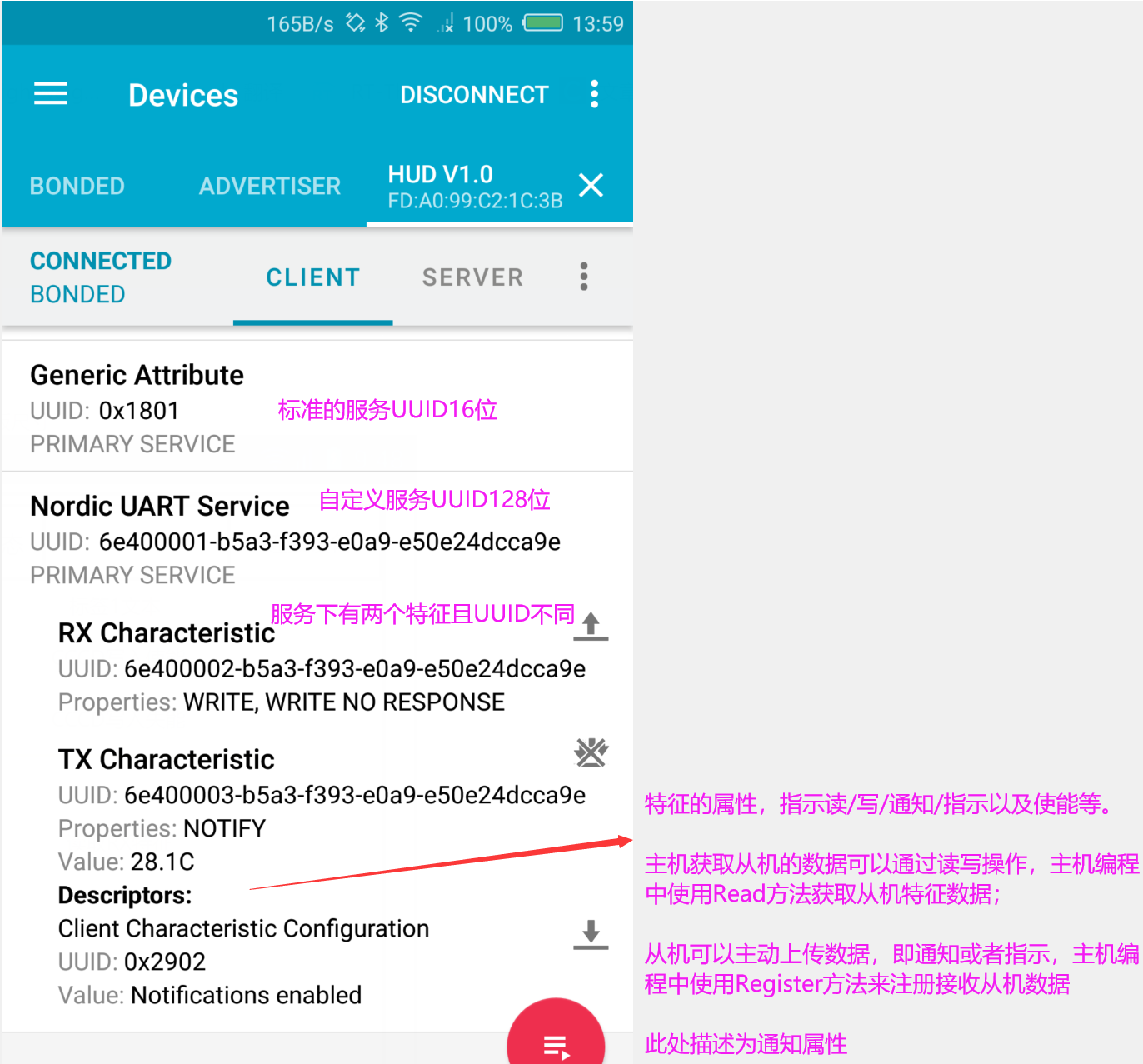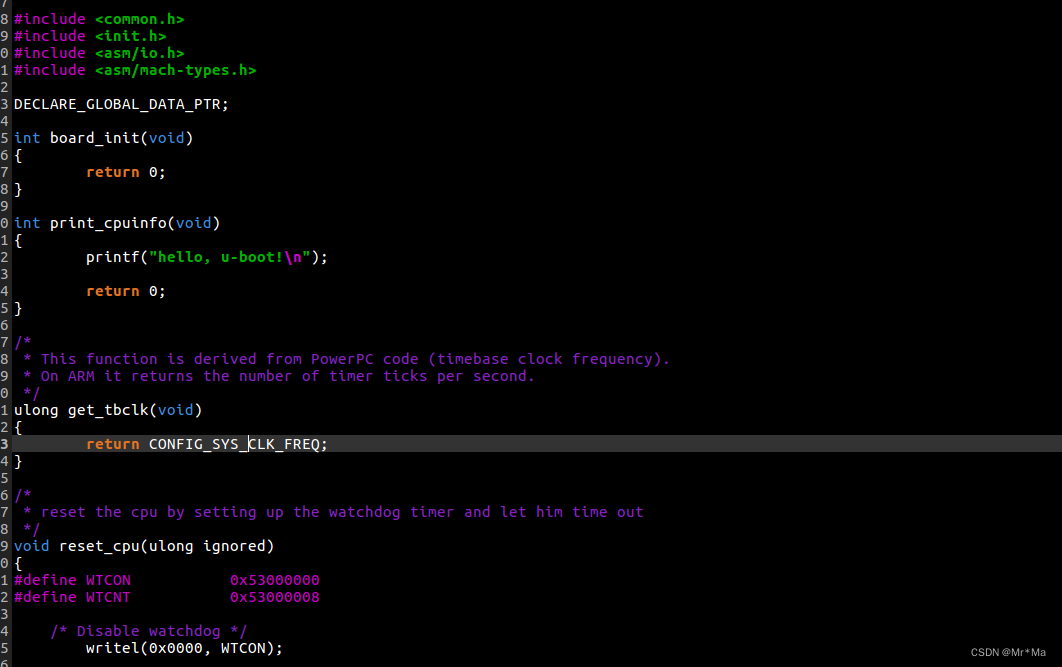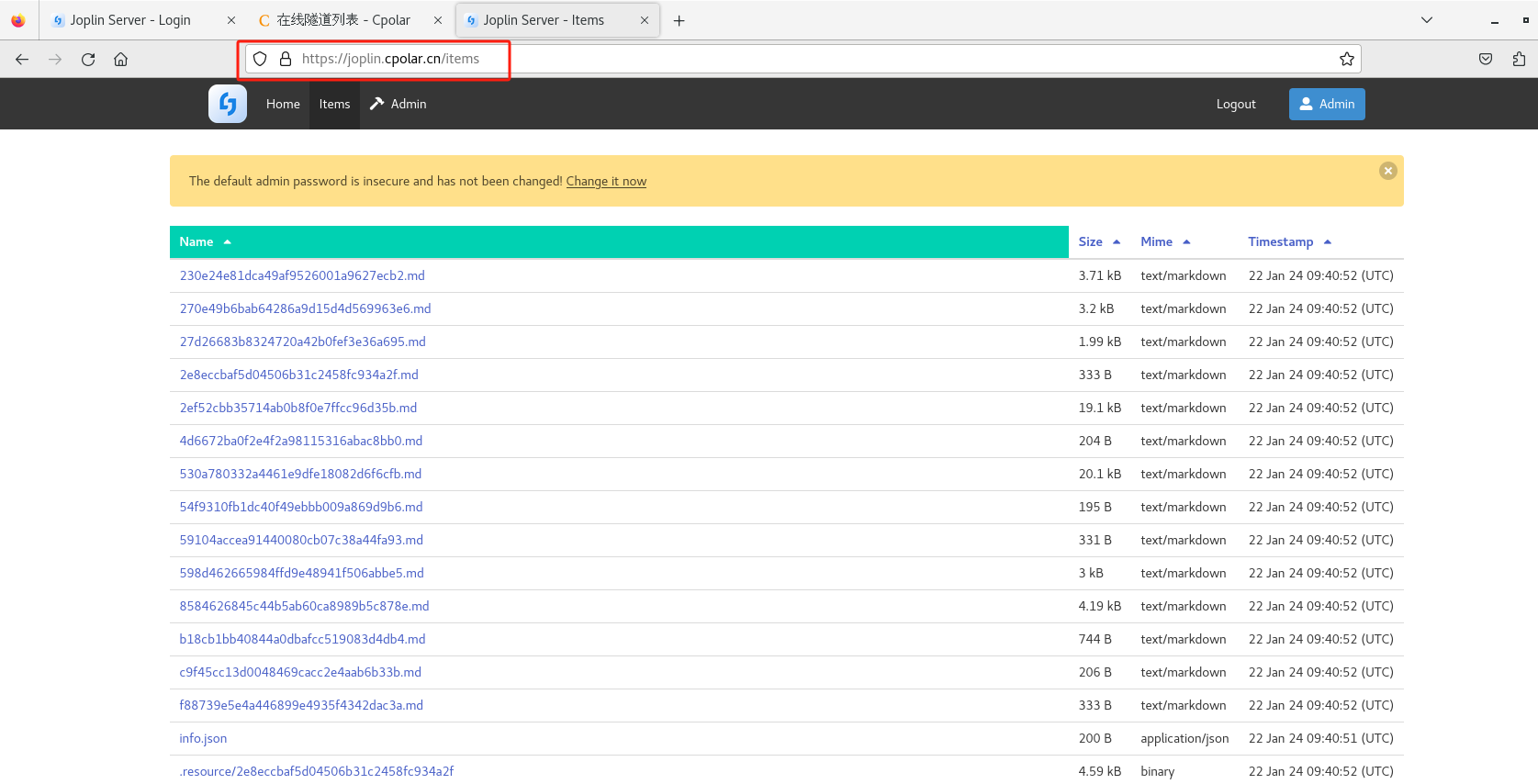一、consul的相关知识
1.1 什么是注册与发现
服务注册与发现是微服务架构中不可或缺的重要组件。起初服务都是单节点的,不保障高可用性,也不考虑服务的压力承载,服务之间调用单纯的通过接口访问。直到后来出现了多个节点的分布式架构,起初的解决手段是在服务前端负载均衡,这样前端必须要知道所有后端服务的网络位置,并配置在配置文件中。这里就会有几个问题:
●如果需要调用后端服务A-N,就需要配置N个服务的网络位置,配置很麻烦
●后端服务的网络位置变化,都需要改变每个调用者的配置
既然有这些问题,那么服务注册与发现就是解决这些问题的。后端服务A-N可以把当前自己的网络位置注册到服务发现模块,服务发现就以K-V的方式记录下来,K一般是服务名,V就是IP:PORT。服务发现模块定时的进行健康检查,轮询查看这些后端服务能不能访问的了。前端在调用后端服务A-N的时候,就跑去服务发现模块问下它们的网络位置,然后再调用它们的服务。这样的方式就可以解决上面的问题了,前端完全不需要记录这些后端服务的网络位置,前端和后端完全解耦!
1.2 什么是consul
consul是google开源的一个使用go语言开发的服务管理软件。支持多数据中心、分布式高可用的、服务发现和配置共享。采用Raft算法,用来保证服务的高可用。内置了服务注册与发现框架、分布一致性协议实现、健康检查、Key/Value存储、多数据中心方案,不再需要依赖其他工具(比如ZooKeeper等)。服务部署简单,只有一个可运行的二进制的包。每个节点都需要运行agent,他有两种运行模式server 和 client。 每个数据中心官方建议需要3或5个server节点以保证数据安全,同时保证server-leader的选举能够正确的进行。
在client模式下,所有注册到当前节点的服务会被转发到server节点,本身是不持久化这些信息。
在server模式下,功能和client模式相似,唯一不同的是,它会把所有的信息持久化到本地,这样遇到故障,信息是可以被保留的。
server-leader是所有server节点的老大,它和其它server节点不同的是,它需要负责同步注册的信息给其它的server节点,同时也要负责各个节点的健康监测。
consul提供的一些关键特性:
服务注册与发现:consul通过DNS或者HTTP接口使服务注册和服务发现变的很容易,一些外部服务,例如saas提供的也可以一样注册。
健康检查:健康检测使consul可以快速的告警在集群中的操作。和服务发现的集成,可以防止服务转发到故障的服务上面。
Key/Value存储:一个用来存储动态配置的系统。提供简单的HTTP接口,可以在任何地方操作。
多数据中心:无需复杂的配置,即可支持任意数量的区域。
安装consul是用于服务注册,也就是容器本身的一些信息注册到consul里面,其他程序可以通过consul获取注册的相关服务信息,这就是服务注册与发现。
1.3 zookeeper和consul的区别
zookeeper使用临时节点特性来用于服务发现(当服务断开时,临时节点删除)这种服务发现机制比心跳检测更精致,复杂,但是同样也有一些固有的扩展性问题和增加客户端复杂性,所有的服务端都必须维持同zookeeper的活动连接。
consul的服务发现机制:Consul在集群的每一个节点都运行一个客户端,这些客户端就是 gossip pool(分布式健康检查 分布式健康检查)的一部分,gossip协议实现在服务宕机发现上很高效,无论服务集群中服务数多少,Consul可以通过简单的检查服务返回200状态来进行健康检查。
| 对比的项目 | consul | zookeeper |
| 一致性协议 | cp模型 | cp模型 |
| 健康检查 | TCP/HTTP/gRPC/Cmd | KeepAlive |
| 负载均衡策略 | Fabio | - |
| 雪崩保护 | 无 | 无 |
| 自动注销实例 | 不支持 | 支持 |
| 访问协议 | HTTP/DNS | TCP |
| 监听支持 | 支持 | 支持 |
| 多数据中心 | 支持 | 不支持 |
| 跨注册中心同步 | 支持 | 不支持 |
| SpringCloud集成 | 支持 | 不支持 |
| Dubbo集成 | 不支持 | 支持 |
| K8s集成 | 支持 | 不支持 |
二、consul 部署
| 服务器 | IP | 主要作用 |
| consul服务器 | 192.168.136.198 | 运行consul服务、nginx服务、consul-template守护进程 |
| registrator服务器 | 192.168.136.150 | 运行registrator容器、运行nginx容器 |
2.1 部署consul服务器
systemctl stop firewalld.service
setenforce 0
-------- consul服务器 --------
1. 建立 Consul 服务
mkdir /opt/consul
cp consul_0.9.2_linux_amd64.zip /opt/consul
cd /opt/consul
unzip consul_0.9.2_linux_amd64.zip
mv consul /usr/local/bin/
//设置代理,在后台启动 consul 服务端
consul agent \
-server \
-bootstrap \
-ui \
-data-dir=/var/lib/consul-data \
-bind=192.168.80.15 \
-client=0.0.0.0 \
-node=consul-server01 &> /var/log/consul.log &
----------------------------------------------------------------------------------------------------------
-server: 以server身份启动。默认是client。
-bootstrap :用来控制一个server是否在bootstrap模式,在一个数据中心中只能有一个server处于bootstrap模式,当一个server处于 bootstrap模式时,可以自己选举为 server-leader。
-bootstrap-expect=2 :集群要求的最少server数量,当低于这个数量,集群即失效。
-ui :指定开启 UI 界面,这样可以通过 http://localhost:8500/ui 这样的地址访问 consul 自带的 web UI 界面。
-data-dir :指定数据存储目录。
-bind :指定用来在集群内部的通讯地址,集群内的所有节点到此地址都必须是可达的,默认是0.0.0.0。
-client :指定 consul 绑定在哪个 client 地址上,这个地址提供 HTTP、DNS、RPC 等服务,默认是 127.0.0.1。
-node :节点在集群中的名称,在一个集群中必须是唯一的,默认是该节点的主机名。
-datacenter :指定数据中心名称,默认是dc1。
----------------------------------------------------------------------------------------------------------
netstat -natp | grep consul


consul agent -server -bootstrap -ui -data-dir=/opt/consul/data -bind=192.168.136.198 -client=0.0.0.0 -node=consul-server01 &> /opt/consul/logs/consul.log &

2. 查看集群信息
#查看members状态
consul members
#查看集群状态
consul operator raft list-peers
consul info | grep leader
3. 通过 http api 获取集群信息
curl 127.0.0.1:8500/v1/status/peers #查看集群server成员
curl 127.0.0.1:8500/v1/status/leader #集群 server-leader
curl 127.0.0.1:8500/v1/catalog/services #注册的所有服务
curl 127.0.0.1:8500/v1/catalog/nginx #查看 nginx 服务信息
curl 127.0.0.1:8500/v1/catalog/nodes #集群节点详细信息


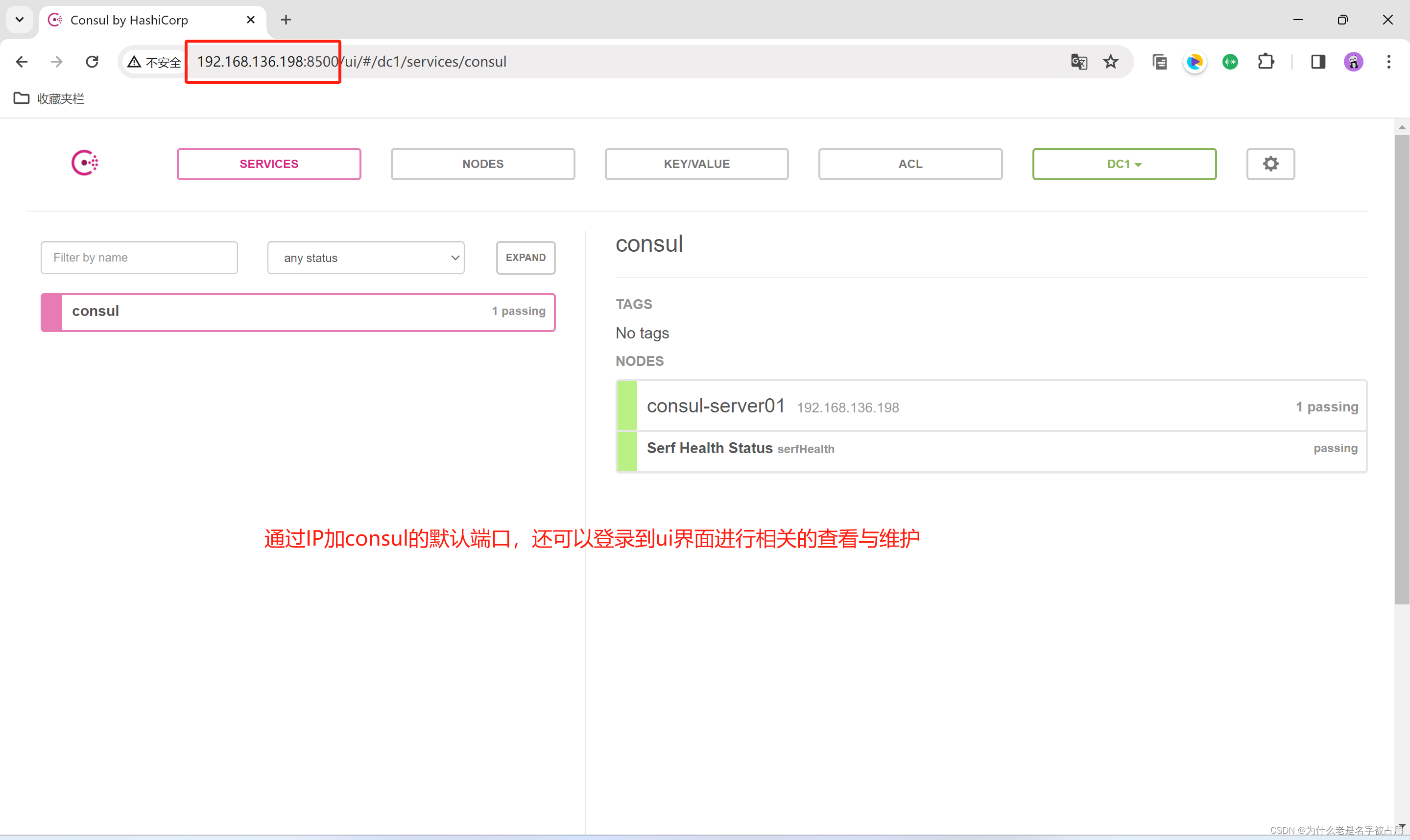
2.2 registrator服务器
//容器服务自动加入 Nginx 集群
1. 安装 Gliderlabs/Registrator
Gliderlabs/Registrator 可检查容器运行状态自动注册,还可注销 docker 容器的服务到服务配置中心。目前支持 Consul、Etcd 和 SkyDNS2。
docker run -d \
--name=registrator \
--net=host \
-v /var/run/docker.sock:/tmp/docker.sock \
--restart=always \
gliderlabs/registrator:latest \
--ip=192.168.136.150 \
consul://192.168.136.198:8500
----------------------------------------------------------------------------------------------------------
--net=host :把运行的docker容器设定为host网络模式。
-v /var/run/docker.sock:/tmp/docker.sock :把宿主机的Docker守护进程(Docker daemon)默认监听的Unix域套接字挂载到容器中。
--restart=always :设置在容器退出时总是重启容器。
--ip :刚才把network指定了host模式,所以我们指定ip为宿主机的ip。
consul :指定consul服务器的IP和端口。
----------------------------------------------------------------------------------------------------------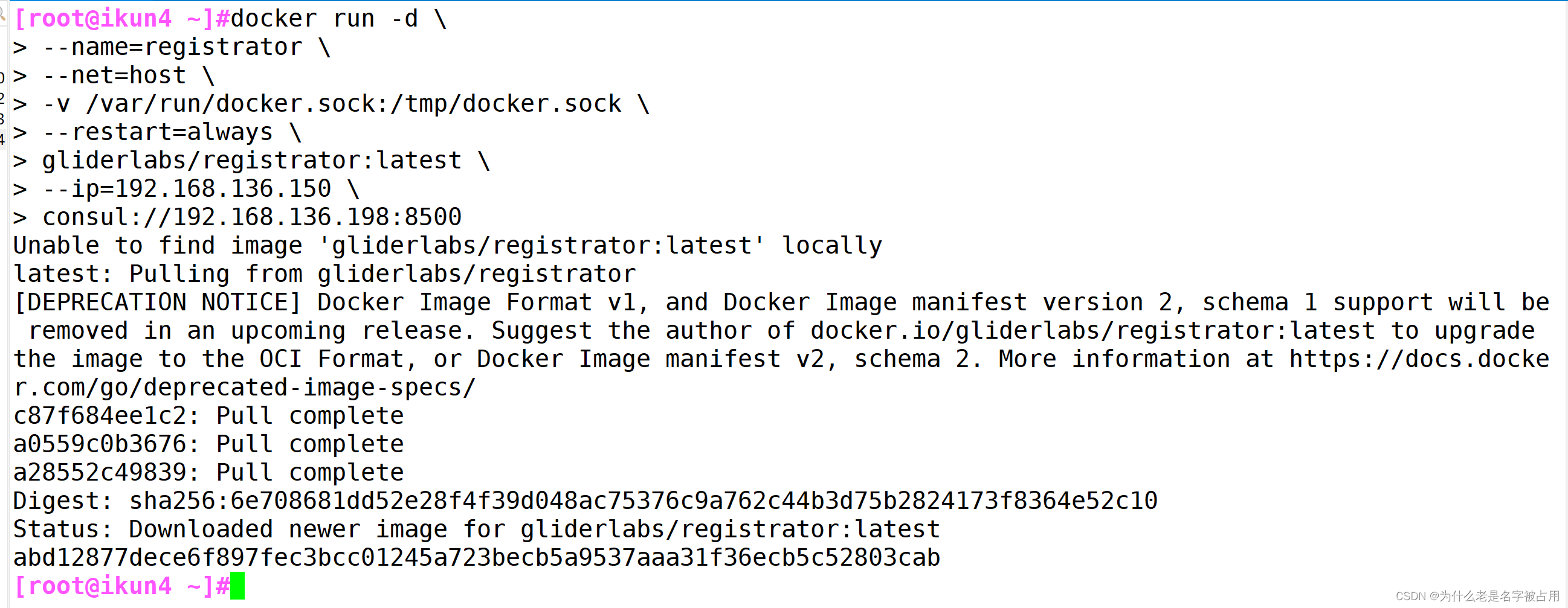

2. 测试服务发现功能是否正常
yum -y install nginx
docker run -d -p 9526:80 --name n1 nginx:1.24
docker run -d -p 9527:80 --name n2 nginx:1.24
docker run -d -p 9528:80 --name n3 nginx:1.24
docker run -d -p 9529:80 --name n4 nginx:1.24
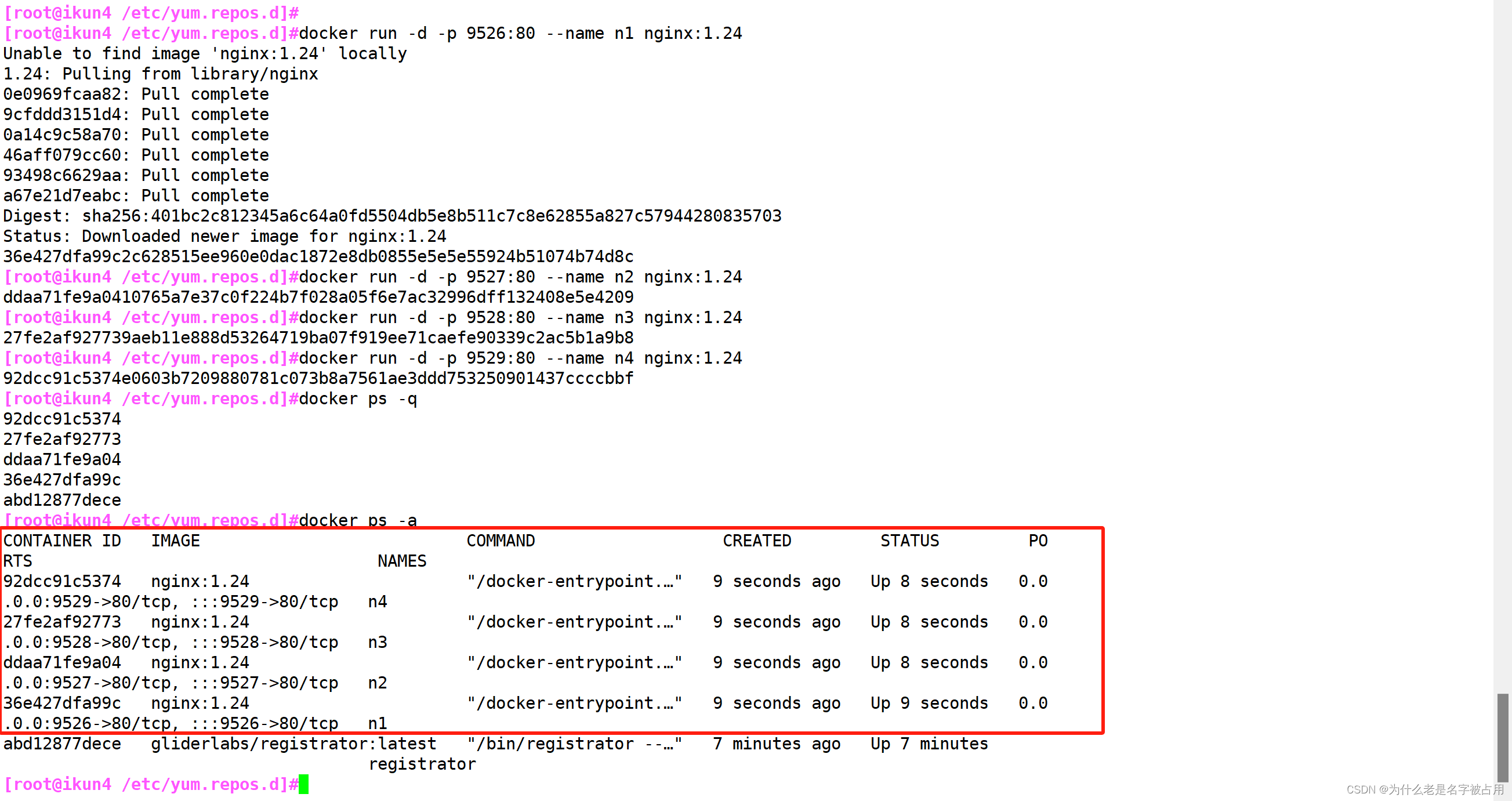
3. 验证 http 和 nginx 服务是否注册到 consul
浏览器中,输入 http://192.168.73.105:8500,在 Web 页面中“单击 NODES”,然后单击“consurl-server01”,会出现 5 个服务。
//在consul服务器使用curl测试连接服务器
curl 127.0.0.1:8500/v1/catalog/services 

三、consul-template 的引入
3.1 consul-template的作用
Consul-Template是基于Consul的自动替换配置文件的应用。Consul-Template是一个守护进程,用于实时查询Consul集群信息,并更新文件系统上任意数量的指定模板,生成配置文件。更新完成以后,可以选择运行 shell 命令执行更新操作,重新加载 Nginx。
Consul-Template可以查询Consul中的服务目录、Key、Key-values 等。这种强大的抽象功能和查询语言模板可以使 Consul-Template 特别适合动态的创建配置文件。例如:创建Apache/Nginx Proxy Balancers 、 Haproxy Backends等。
3.2 consul-template的具体部署运用
(1)准备 template nginx 模板文件
vim nginx.ctmpl
upstream nginx-backend {
{{range service "nginx"}}
server {{.Address}}:{{.Port}};
{{end}}
}

(2) 安装配置 nginx
yum -y install nginx
vim /etc/nginx/nginx.conf
user nginx;
worker_processes auto;
error_log /var/log/nginx/error.log notice;
pid /var/run/nginx.pid;
events {
worker_connections 1024;
}
http {
include /etc/nginx/consul.conf;
include /etc/nginx/mime.types;
default_type application/octet-stream;
log_format main '$remote_addr - $remote_user [$time_local] "$request" '
'$status $body_bytes_sent "$http_referer" '
'"$http_user_agent" "$http_x_forwarded_for"';
access_log /var/log/nginx/access.log main;
sendfile on;
#tcp_nopush on;
keepalive_timeout 65;
#gzip on;
include /etc/nginx/conf.d/*.conf;
}
vim /etc/nginx/conf.d/default.conf
server {
listen 80;
server_name localhost;
#access_log /var/log/nginx/host.access.log main;
location / {
#root /usr/share/nginx/html;
#index index.html index.htm;
proxy_set_header HOST $host;
proxy_set_header X-Real-IP $remote_addr;
proxy_set_header X-Forwarded-For $proxy_add_x_forwarded_for;
proxy_pass http://nginx-backend;
}
#error_page 404 /404.html;
# redirect server error pages to the static page /50x.html
#
error_page 500 502 503 504 /50x.html;
location = /50x.html {
root /usr/share/nginx/html;
}
# proxy the PHP scripts to Apache listening on 127.0.0.1:80
#
#location ~ \.php$ {
# proxy_pass http://127.0.0.1;
#}
# pass the PHP scripts to FastCGI server listening on 127.0.0.1:9000
#
#location ~ \.php$ {
# root html;
# fastcgi_pass 127.0.0.1:9000;
# fastcgi_index index.php;
# fastcgi_param SCRIPT_FILENAME /scripts$fastcgi_script_name;
# include fastcgi_params;
#}
# deny access to .htaccess files, if Apache's document root
# concurs with nginx's one
#
#location ~ /\.ht {
# deny all;
#}
}

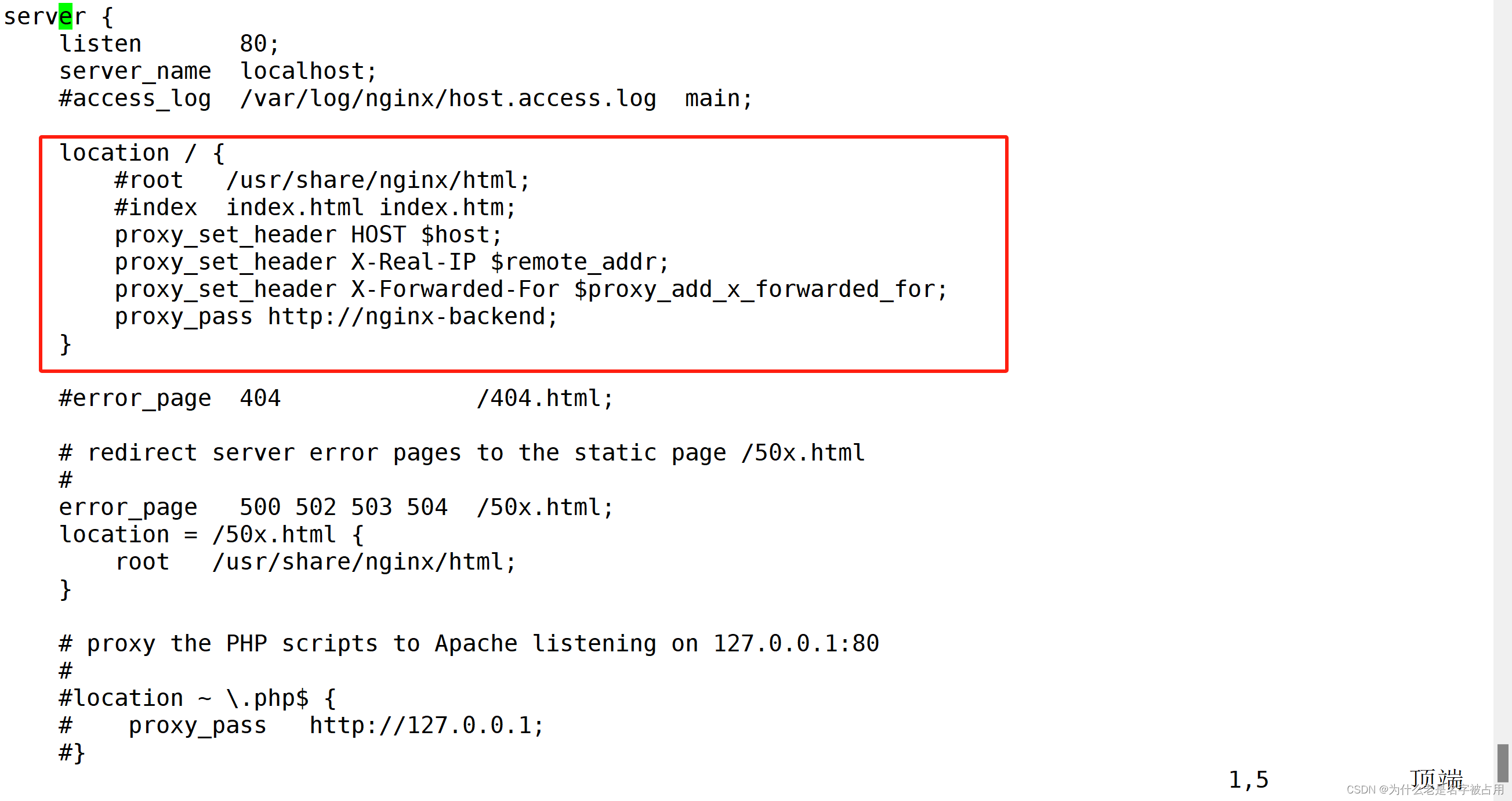
(3) 配置并启动 template
unzip consul-template_0.19.3_linux_amd64.zip -d /opt/
cd /opt/
mv consul-template /usr/local/bin/
//在前台启动 template 服务,启动后不要按 ctrl+c 中止 consul-template 进程。
consul-template --consul-addr 192.168.136.198:8500 --template "/opt/consul-template/nginx.ctmpl:/etc/nginx/consul.conf:/usr/sbin/nginx -s reload" --log-level=info
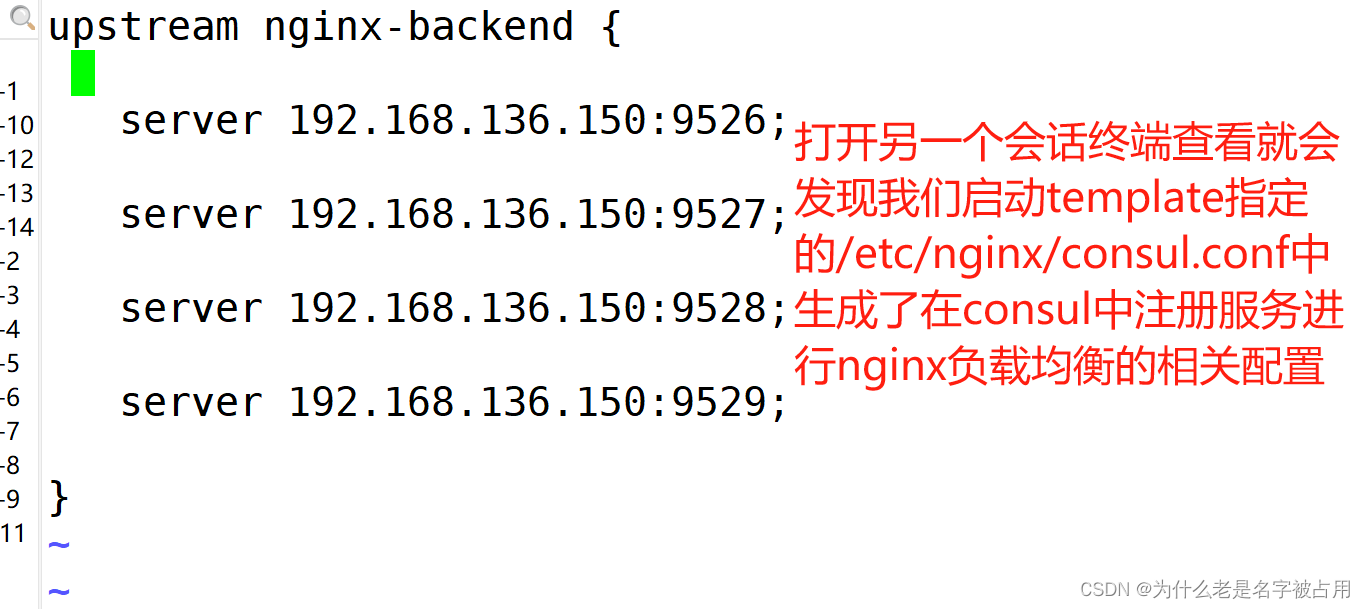
(4)访问 template-nginx
#在registrator主机中
docker ps -a
docker exec -it n1 bash
echo "this is test1 web" > /usr/share/nginx/html/index.html
docker exec -it n2 bash
echo "this is test2 web" > /usr/share/nginx/html/index.html
浏览器访问:http://192.168.136.198:80/ ,并不断刷新。四、consul 多节点部署
//添加一台已有docker环境的服务器192.168.73.107/24加入已有的群集中
#通过sever1(192.168.73.105)将consul执行文件传送给新的服务端
scp consul 192.168.136.150:`pwd` #192.168.136.198的操作
scp consul 192.168.136.197:`pwd
mkdir -p /opt/consul/{data,logs}
consul agent -server -ui -data-dir=/opt/consul/data -bind=192.168.136.150 -client=0.0.0.0 -node=consul-server02 -enable-script-checks=true -datacenter=dc1 -join 192.168.136.198 &> /opt/consul/logs/consul.log &
consul agent -server -ui -data-dir=/opt/consul/data -bind=192.168.136.197 -client=0.0.0.0 -node=consul-server03 -enable-script-checks=true -datacenter=dc1 -join 192.168.136.198 &> /opt/consul/logs/consul.log &
------------------------------------------------------------------------
-enable-script-checks=true :设置检查服务为可用
-datacenter : 数据中心名称
-join :加入到已有的集群中
------------------------------------------------------------------------
consul members
consul operator raft list-peers


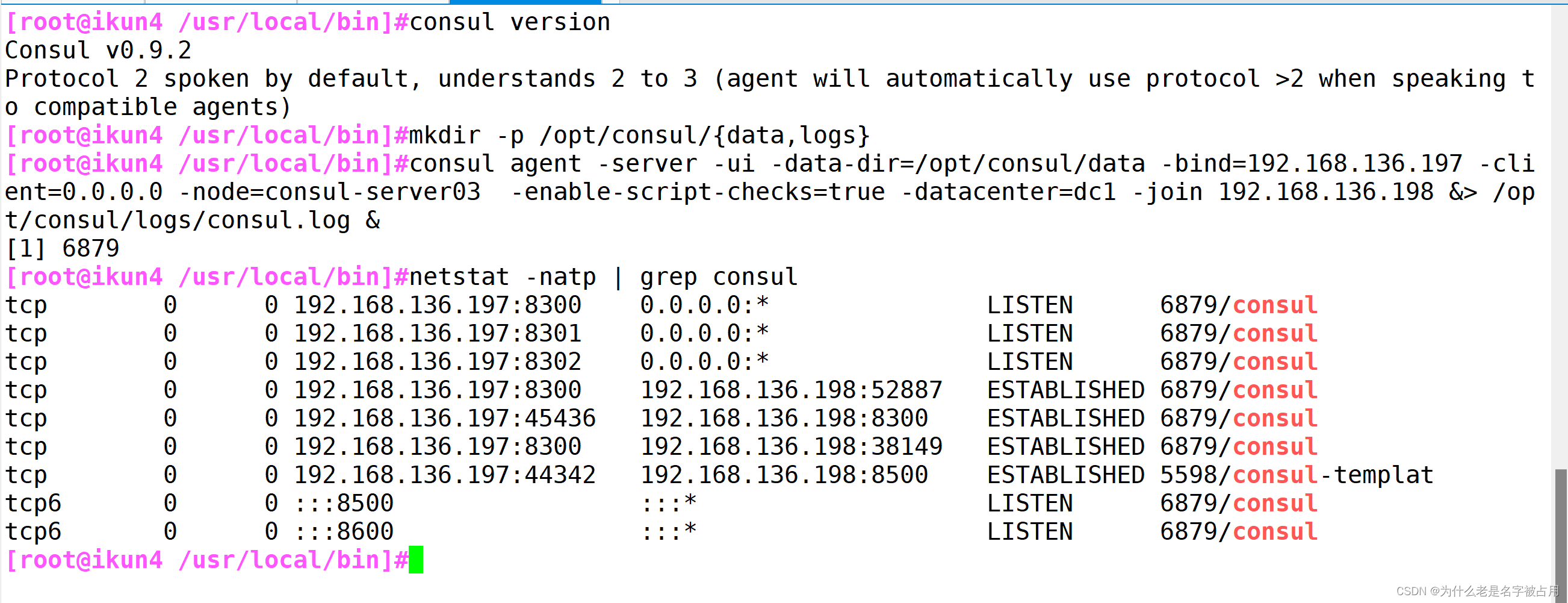

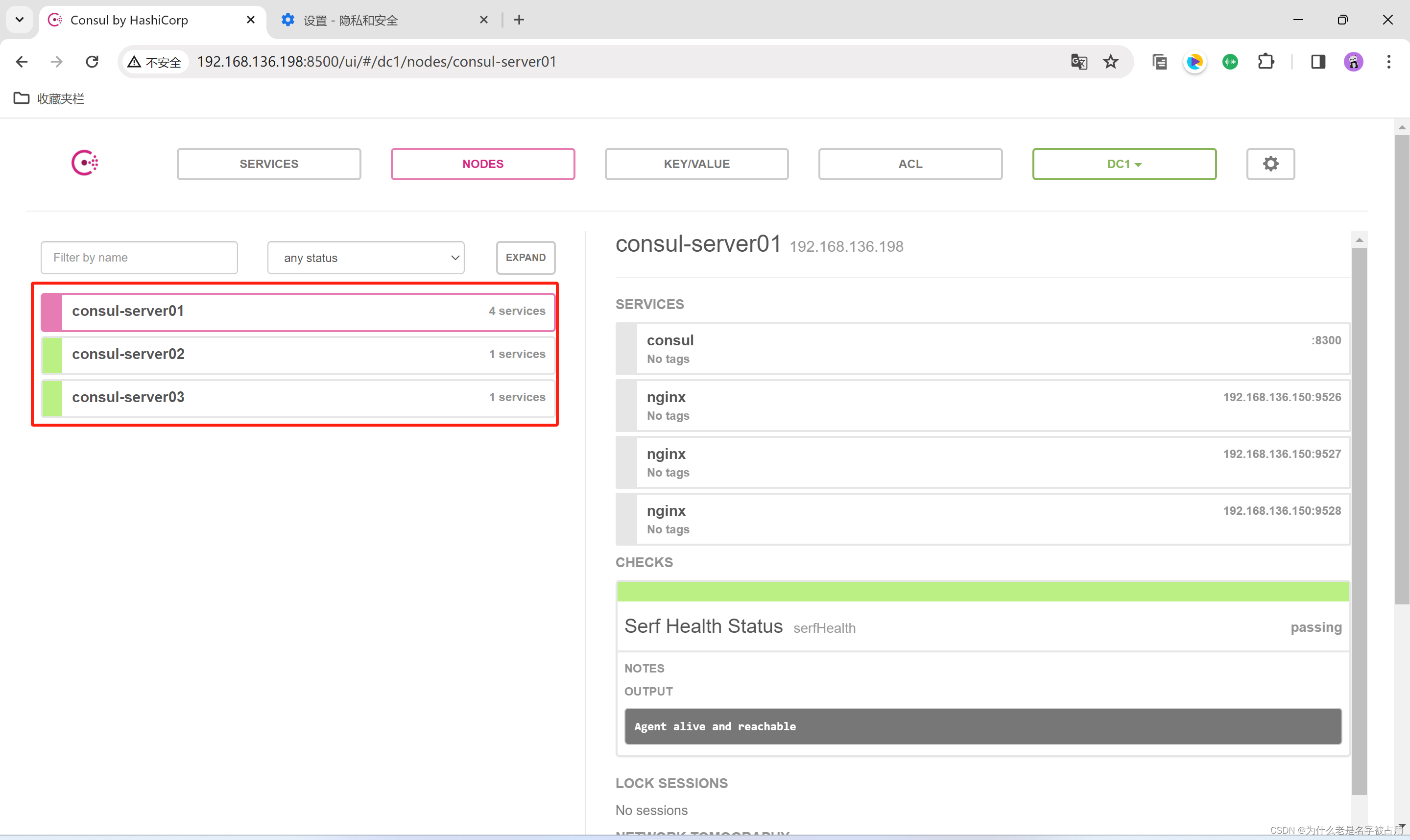
脱离consul集群的方法
consul leave






